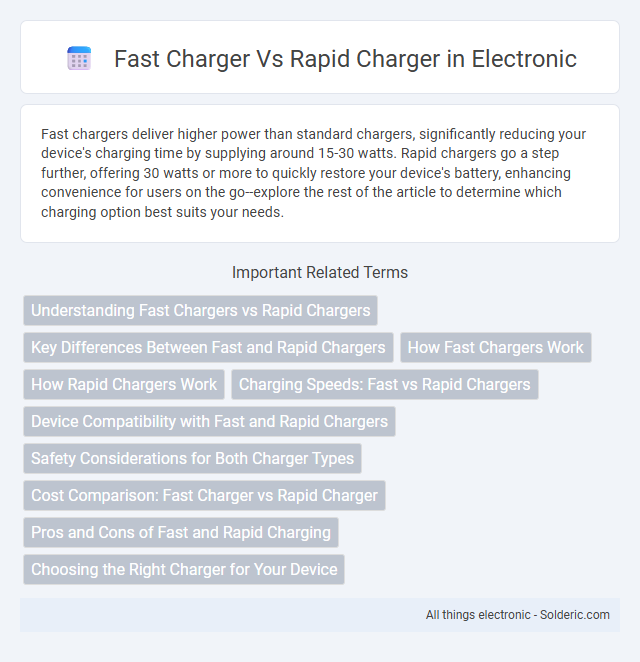Fast chargers deliver higher power than standard chargers, significantly reducing your device's charging time by supplying around 15-30 watts. Rapid chargers go a step further, offering 30 watts or more to quickly restore your device's battery, enhancing convenience for users on the go--explore the rest of the article to determine which charging option best suits your needs.
Comparison Table
| Feature | Fast Charger | Rapid Charger |
|---|---|---|
| Charging Speed | Typically 7 kW to 22 kW | Typically 50 kW to 350 kW |
| Charging Time | 1 to 4 hours for full charge | 20 to 60 minutes for 80% charge |
| Usage | Home and workplace charging | Public fast charging stations |
| Connector Types | Type 1, Type 2, or CHAdeMO | CCS, CHAdeMO, Tesla Supercharger |
| Cost | Lower installation and operational cost | Higher installation and operational cost |
| Battery Impact | Better battery longevity | Potential for faster battery degradation |
Understanding Fast Chargers vs Rapid Chargers
Fast chargers typically deliver power between 7 kW and 22 kW, suitable for home or public use, allowing electric vehicles (EVs) to gain 60-80% charge in about 3 to 4 hours. Rapid chargers provide much higher power, often ranging from 50 kW to 350 kW, enabling an 80% charge in under 30 minutes and are primarily found at highway rest stops for long-distance travel. Understanding the difference helps EV owners select the appropriate charging solution based on time constraints and charger availability.
Key Differences Between Fast and Rapid Chargers
Fast chargers typically deliver power between 7 kW to 22 kW, suitable for home or workplace charging with moderate speed. Rapid chargers provide significantly higher power levels, often ranging from 50 kW up to 350 kW, enabling much quicker battery replenishment on the go. Choosing the right option depends on your driving habits and charging needs, with rapid chargers ideal for fast top-ups during long trips and fast chargers better suited for longer parking durations.
How Fast Chargers Work
Fast chargers work by increasing the power output to deliver a higher voltage and current to the device's battery, enabling quicker energy transfer compared to standard chargers. They use advanced charging protocols such as Qualcomm Quick Charge or USB Power Delivery to communicate with the device and adjust the voltage dynamically for optimal charging speed and safety. This technology reduces charging time by efficiently managing heat and battery health while maximizing power delivery, distinguishing fast chargers from regular chargers with lower amperage and voltage.
How Rapid Chargers Work
Rapid chargers deliver high power output, typically ranging from 50 kW to 350 kW, enabling electric vehicles to charge significantly faster than standard fast chargers, which usually provide up to 50 kW. They utilize direct current (DC) power, bypassing the vehicle's onboard charger to supply energy directly to the battery, reducing charge times from hours to just minutes. Understanding how rapid chargers work allows you to maximize charging efficiency and plan longer trips with minimal downtime.
Charging Speeds: Fast vs Rapid Chargers
Fast chargers typically deliver power between 7 kW and 22 kW, suited for home or workplace charging with moderate speed. Rapid chargers provide significantly higher output, ranging from 50 kW up to 350 kW, designed for quick top-ups during travel or short stops. The higher power capacity of rapid chargers translates to substantially reduced charging times compared to fast chargers.
Device Compatibility with Fast and Rapid Chargers
Fast chargers typically support a wide range of devices, including smartphones and tablets, by delivering moderate power levels around 15-25 watts. Rapid chargers provide higher power output, often exceeding 25 watts, and are optimized for newer devices that support advanced charging protocols like USB Power Delivery or Qualcomm Quick Charge. Your device must be compatible with the specific charging standard to benefit from the maximum charging speed offered by either fast or rapid chargers.
Safety Considerations for Both Charger Types
Fast chargers and rapid chargers both incorporate vital safety features such as overcurrent protection, temperature regulation, and automated shutoff to prevent overheating or electrical faults. Your device's compatibility with the charger type is crucial to avoid potential risks like battery damage or fire hazards. Choosing certified chargers with built-in safety mechanisms ensures reliable and secure charging performance.
Cost Comparison: Fast Charger vs Rapid Charger
Fast chargers generally have a lower upfront cost compared to rapid chargers due to less advanced technology and slower charging capabilities. Rapid chargers require a higher investment because they deliver significantly higher power output, reducing charging time but increasing installation and maintenance expenses. The cost difference can impact total cost of ownership, making fast chargers more economical for low-traffic areas and rapid chargers more cost-effective for high-demand charging stations.
Pros and Cons of Fast and Rapid Charging
Fast chargers offer a balanced charging speed, typically providing 7kW to 22kW power, which is gentle on battery health and convenient for overnight or workplace charging but may take several hours for a full charge. Rapid chargers deliver much higher power, often between 50kW and 350kW, drastically reducing charging time to under an hour, ideal for long-distance travel, but frequent use can accelerate battery degradation and might be less compatible with all electric vehicle models. You should weigh the convenience of rapid charging against long-term battery health and consider your regular driving patterns when choosing between fast and rapid chargers.
Choosing the Right Charger for Your Device
Fast chargers typically deliver power between 15W to 30W, making them suitable for everyday smartphones and smaller devices without risking battery health. Rapid chargers, offering 40W or higher, are designed for newer smartphones and tablets requiring swift energy replenishment while maintaining thermal efficiency. Selecting the right charger depends on your device's supported charging protocol and battery capacity to ensure optimal performance and longevity.
fast charger vs rapid charger Infographic

 solderic.com
solderic.com